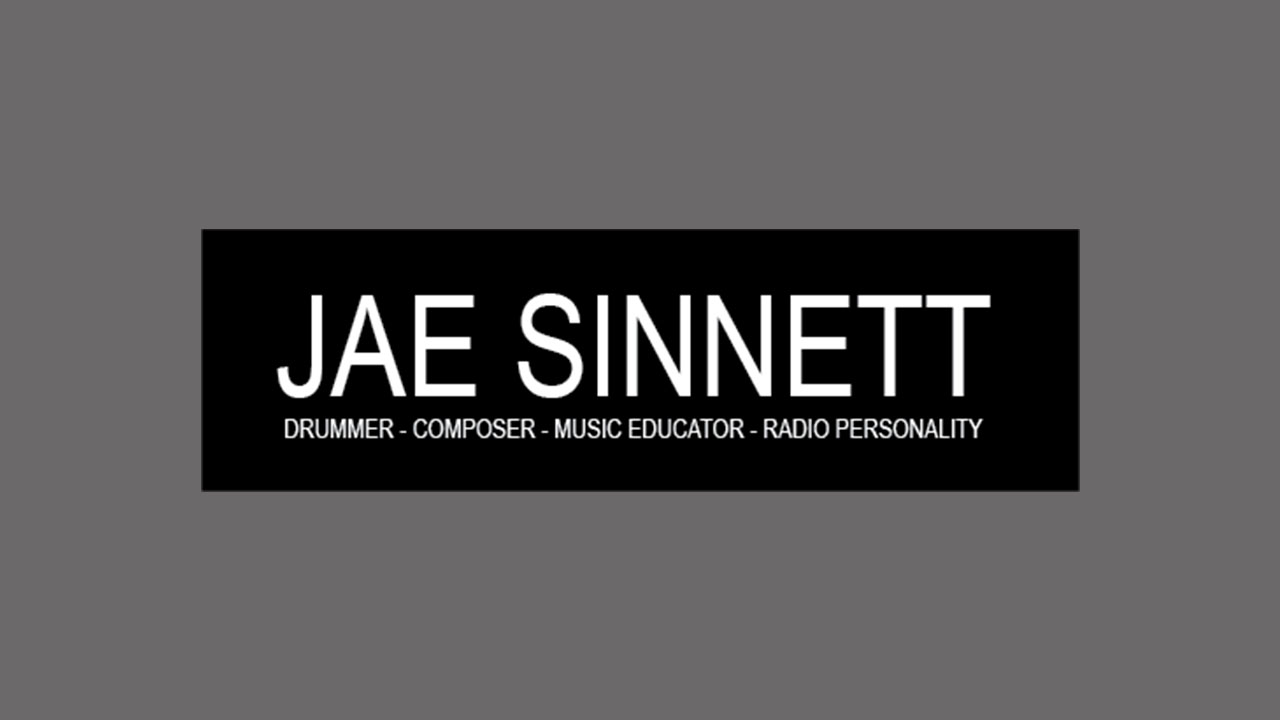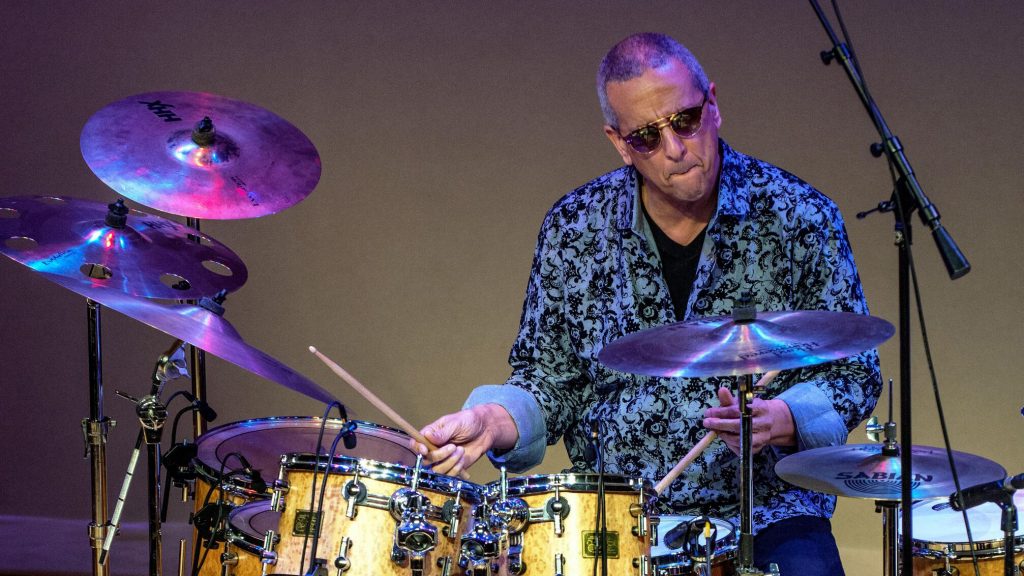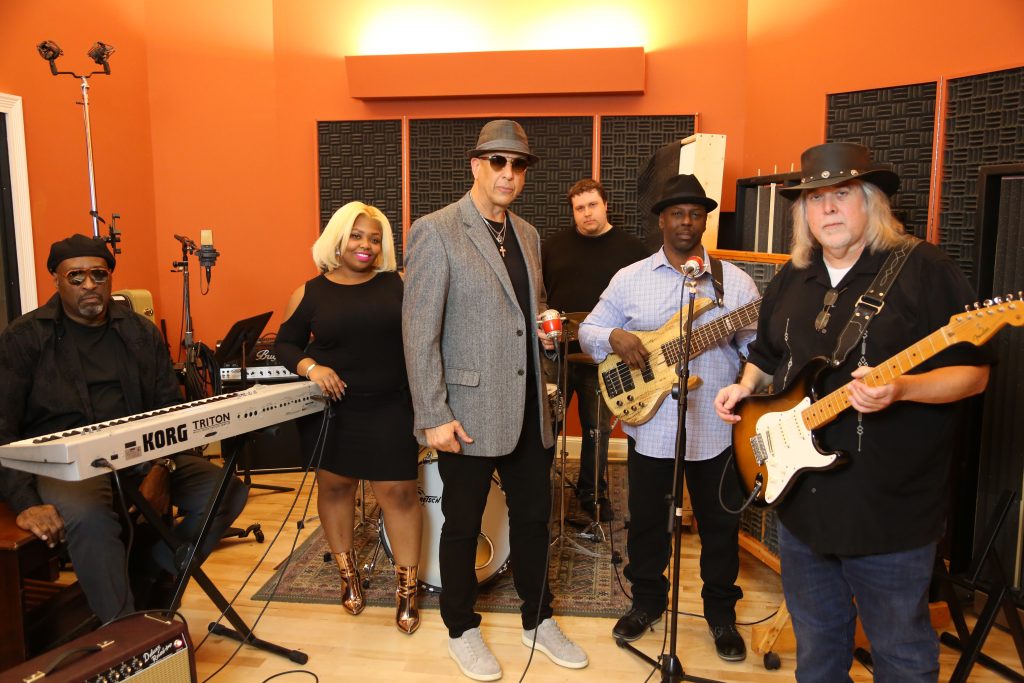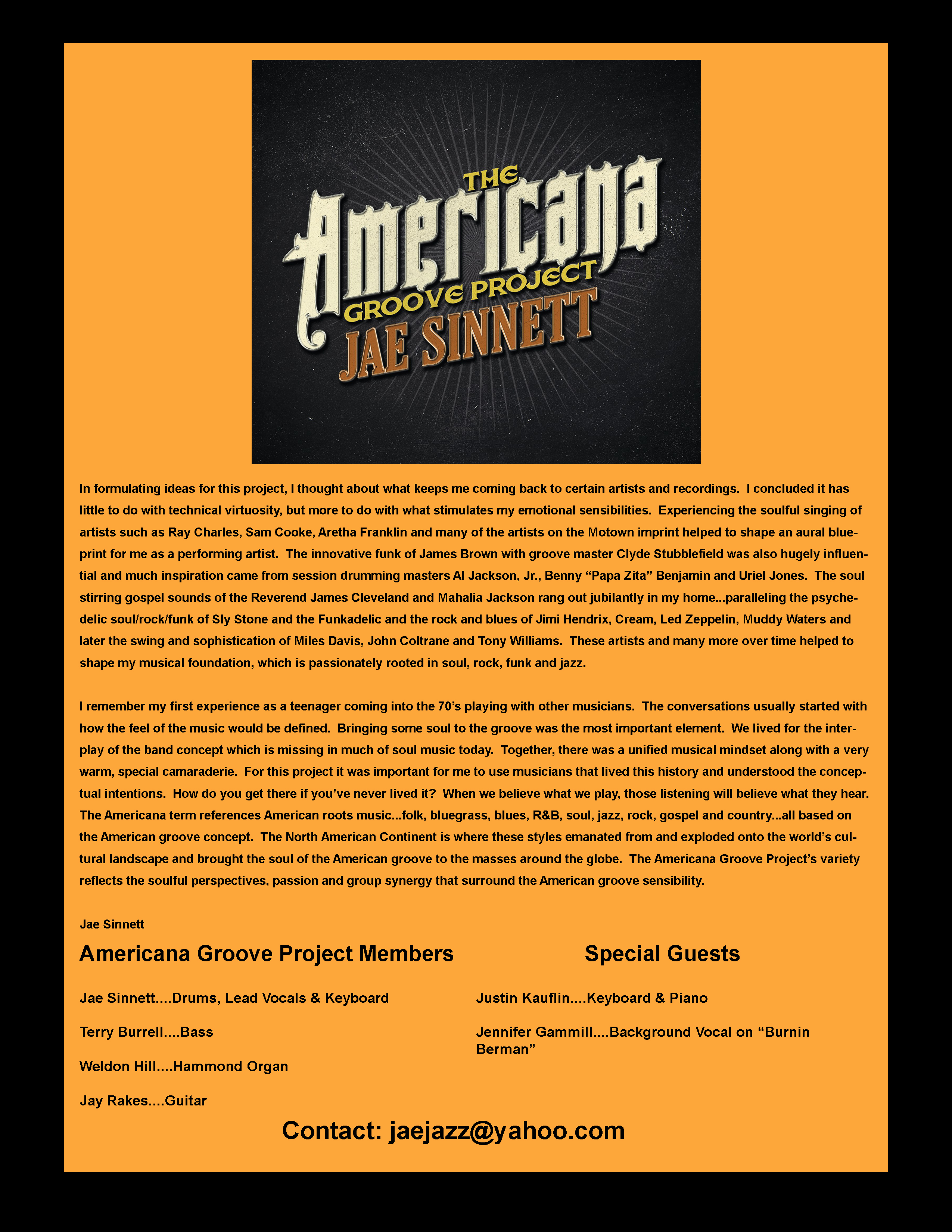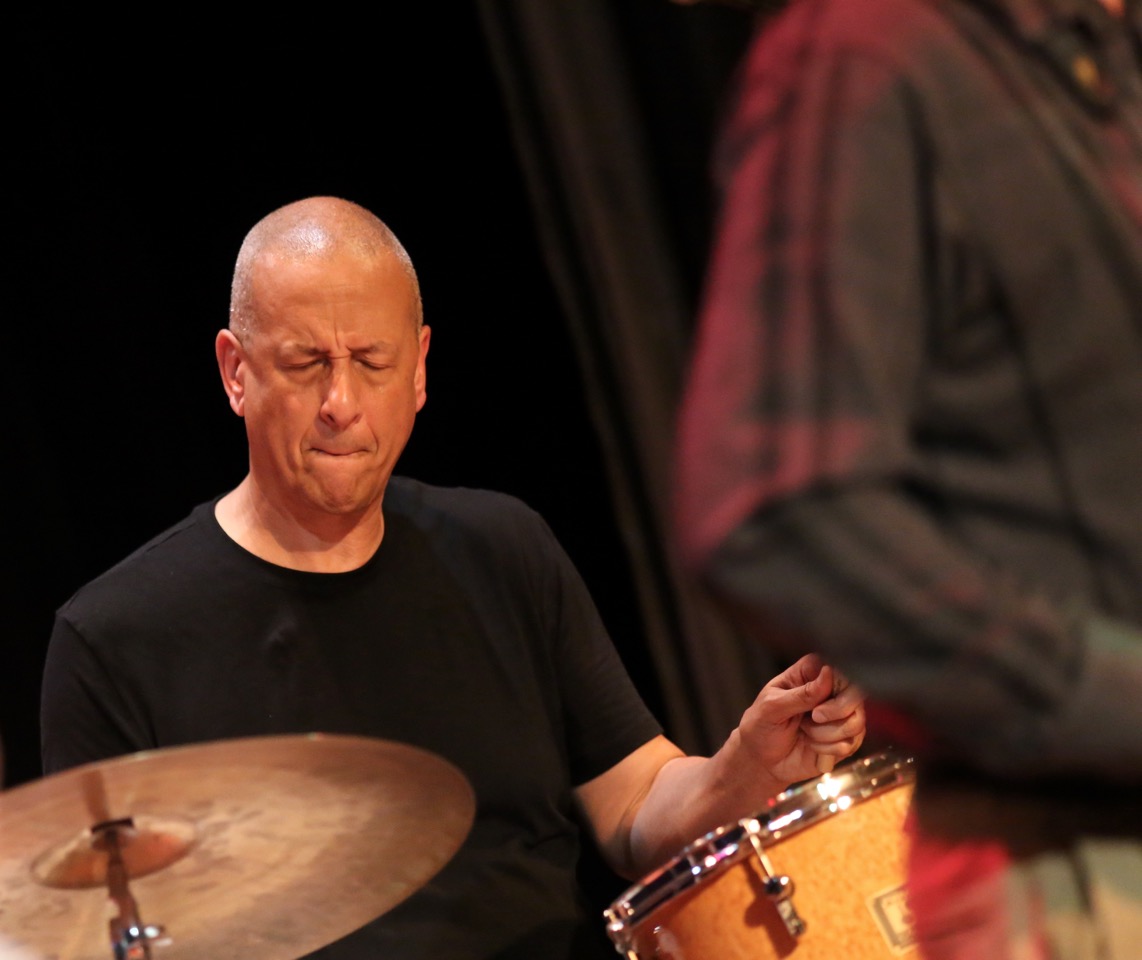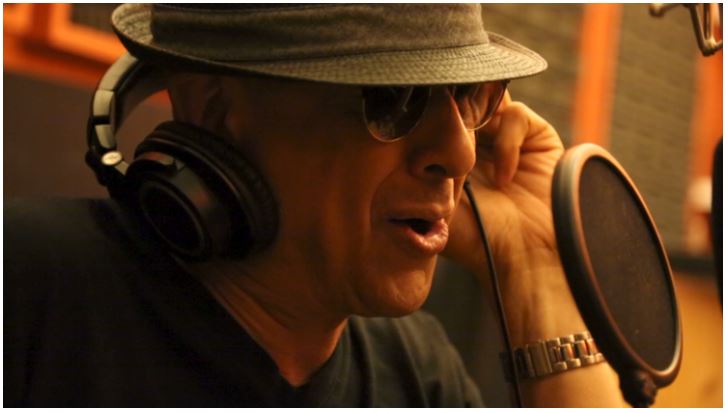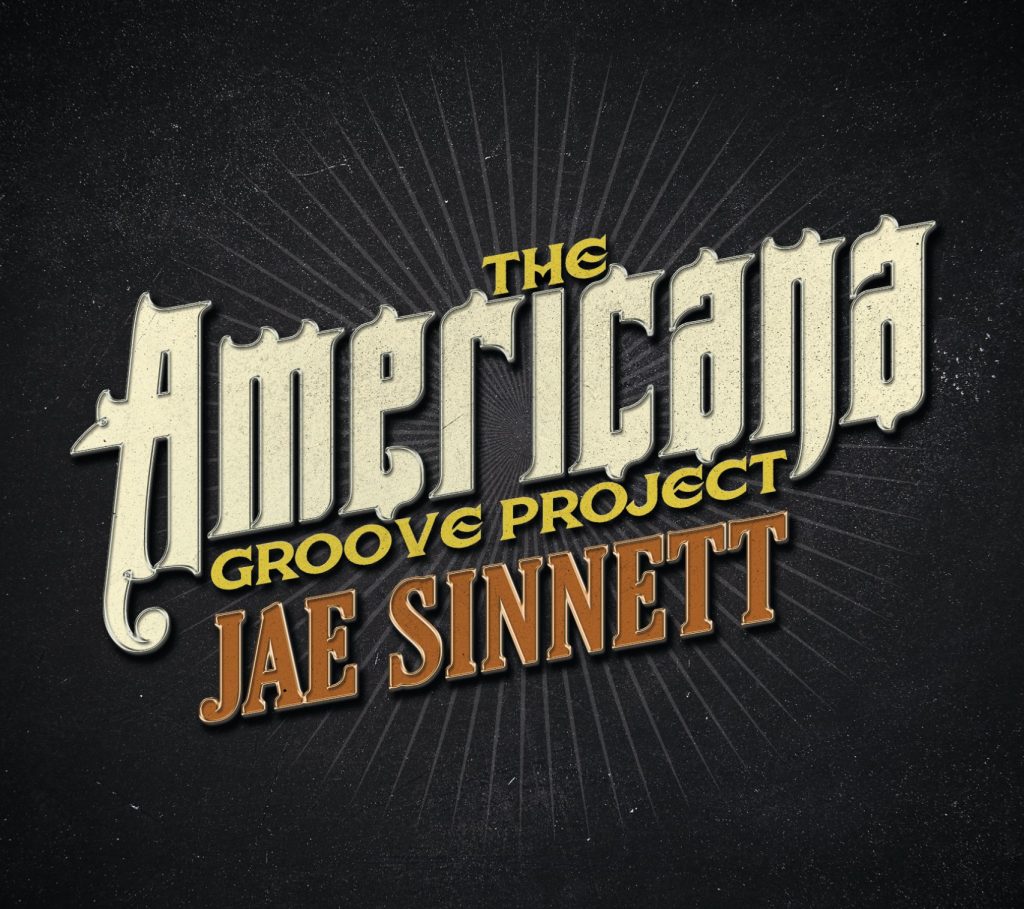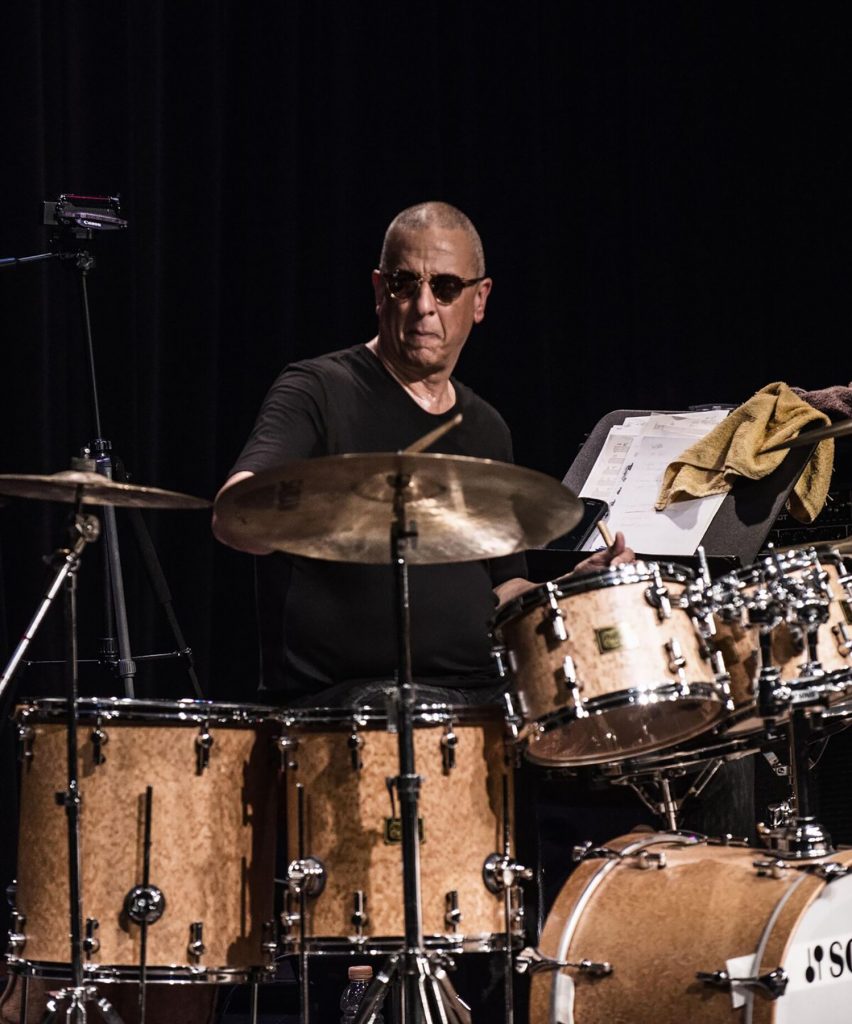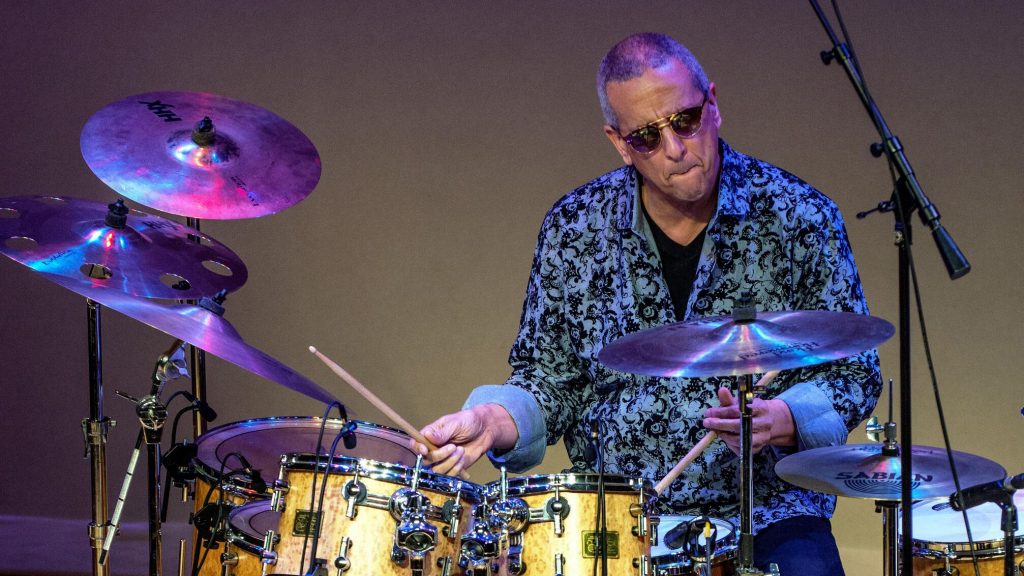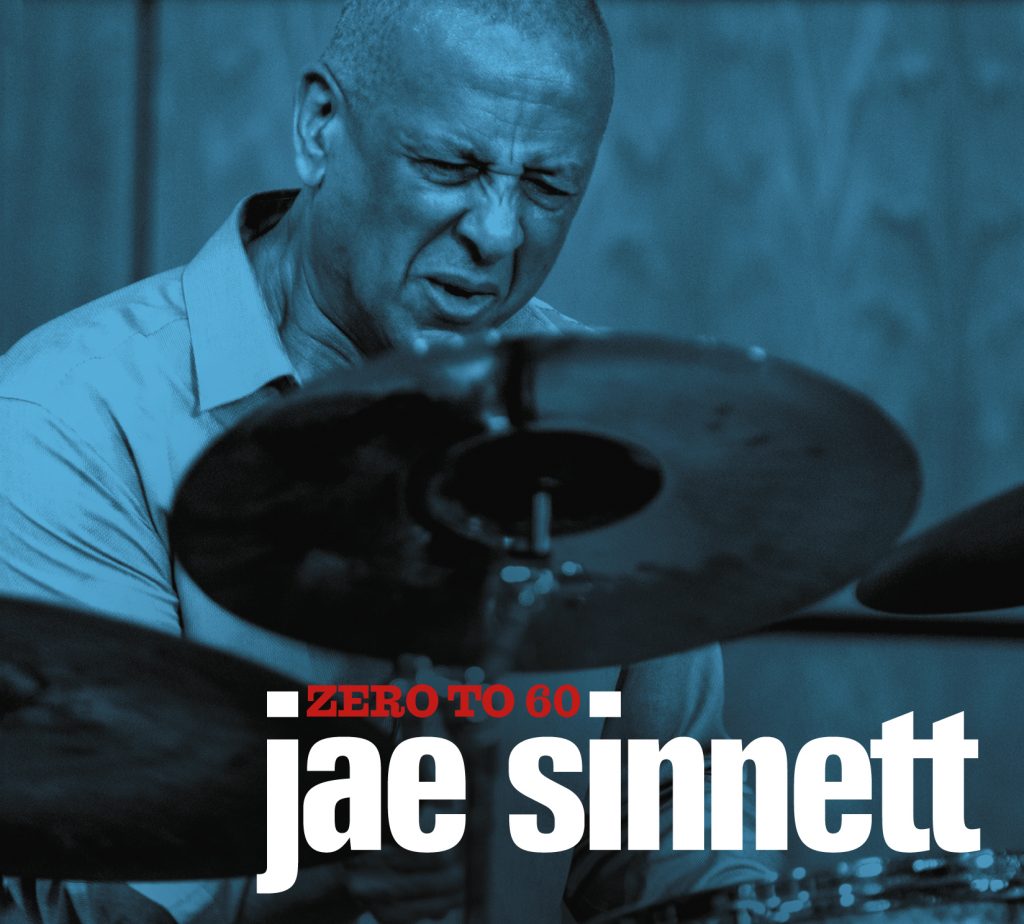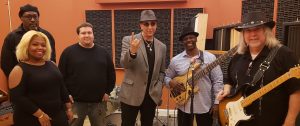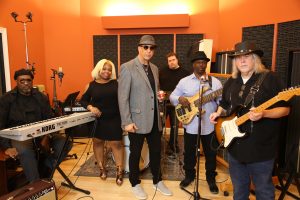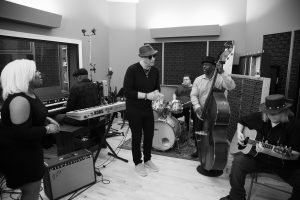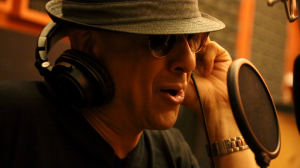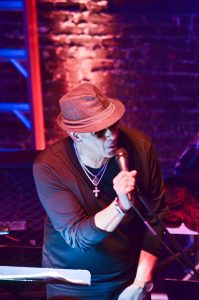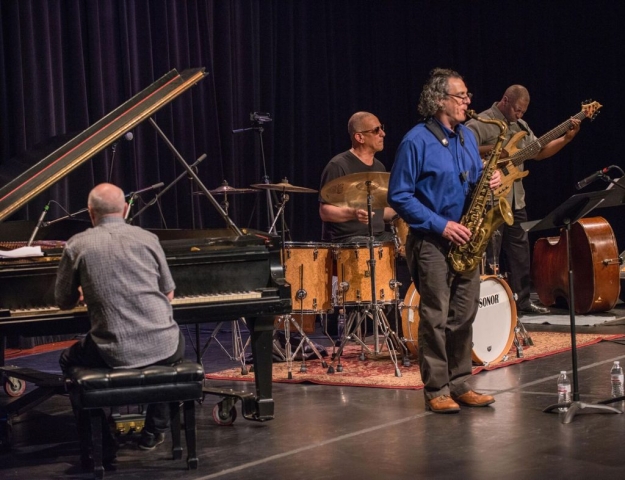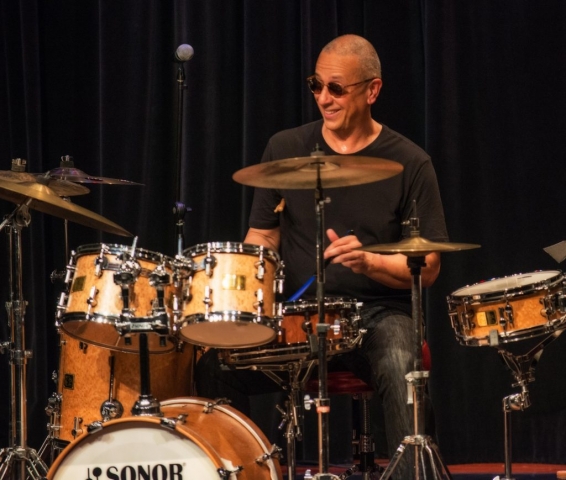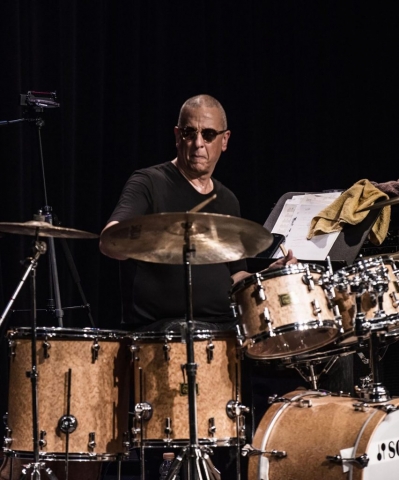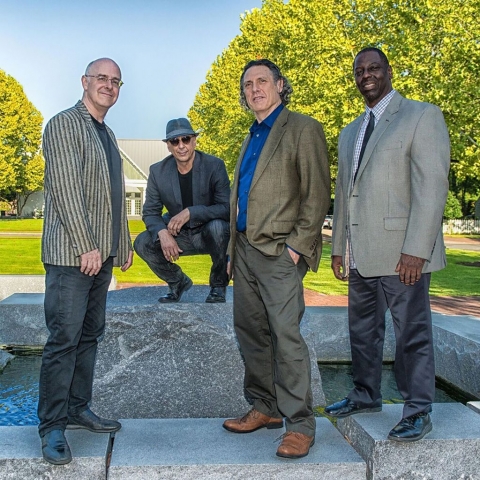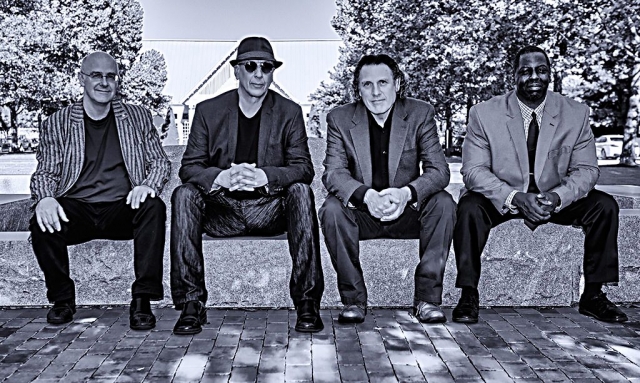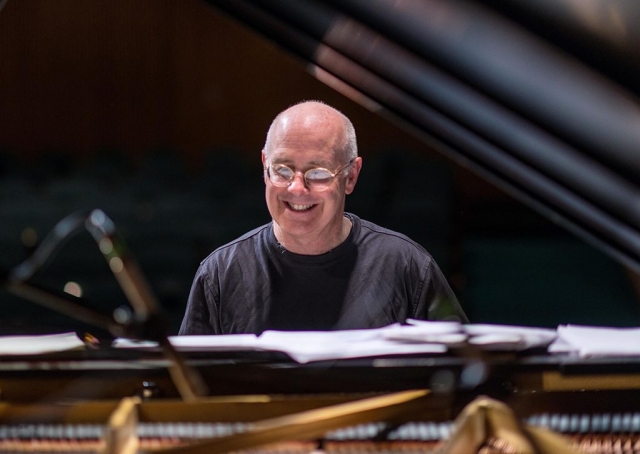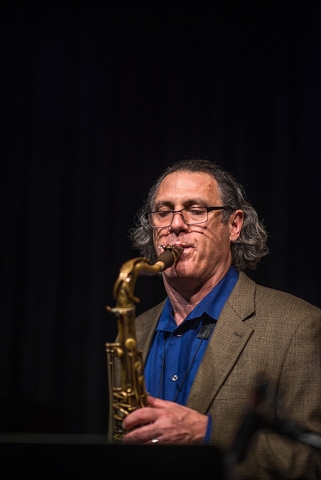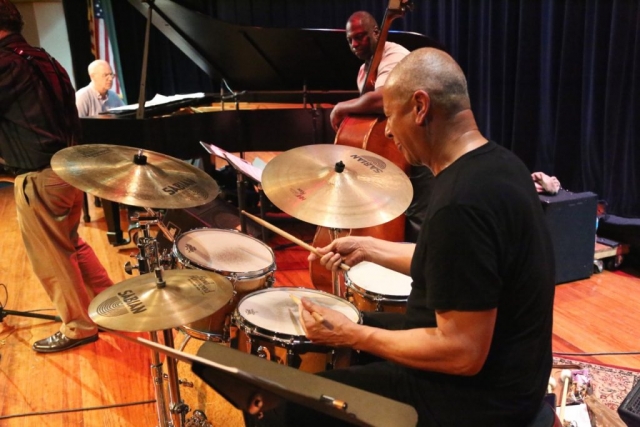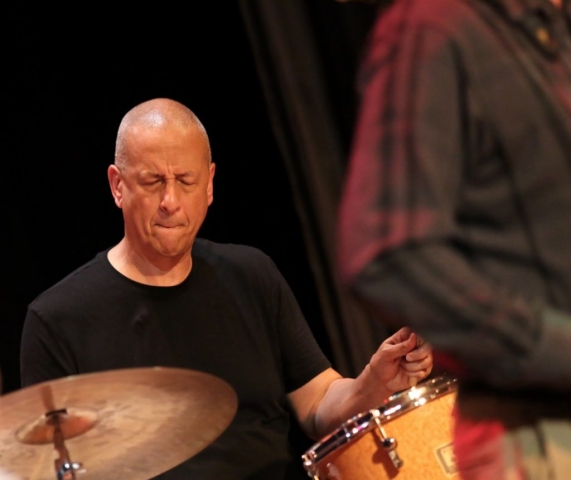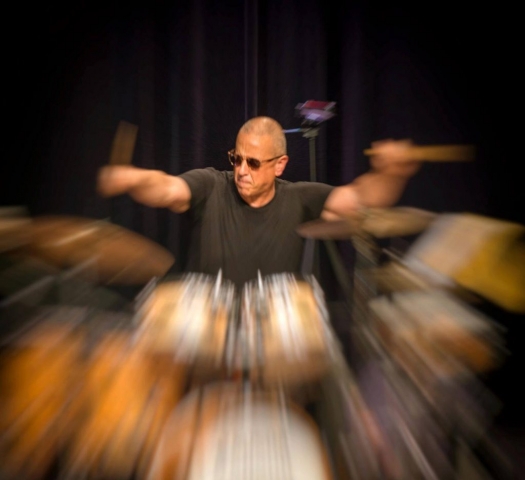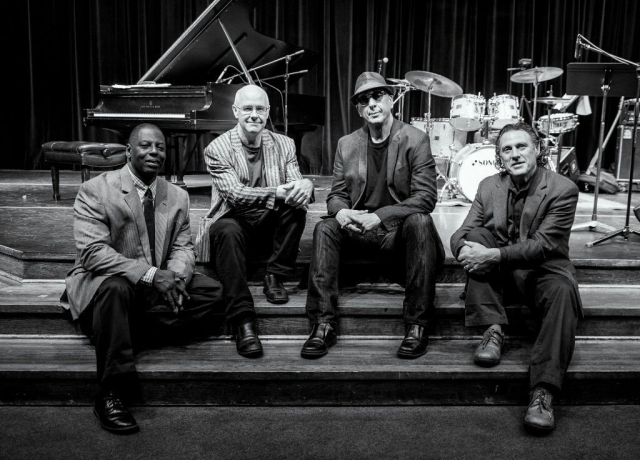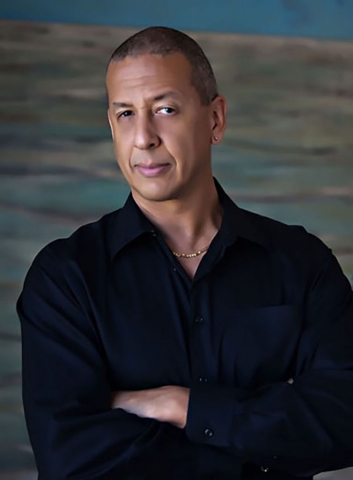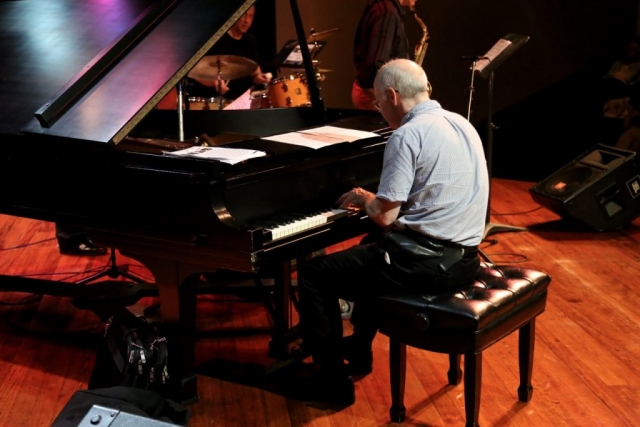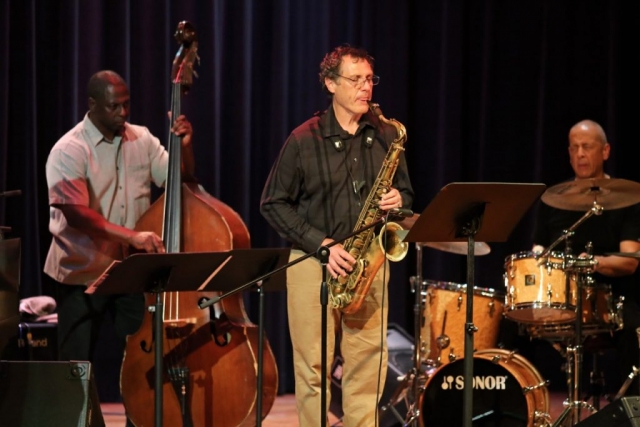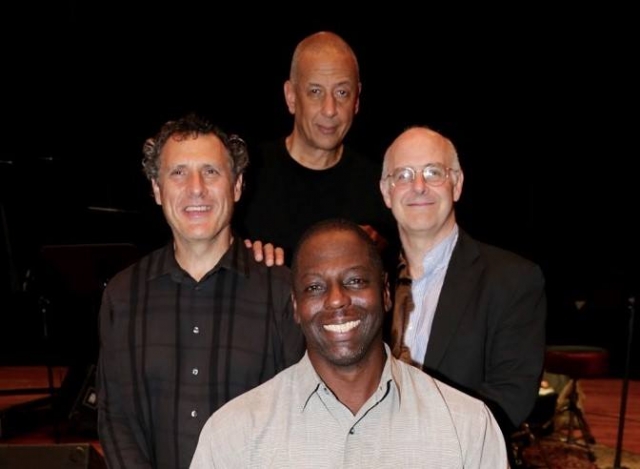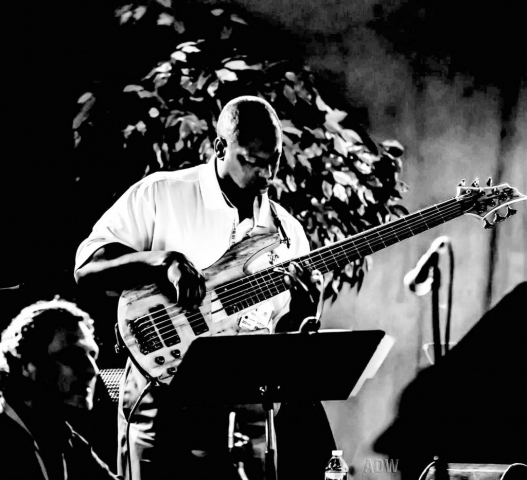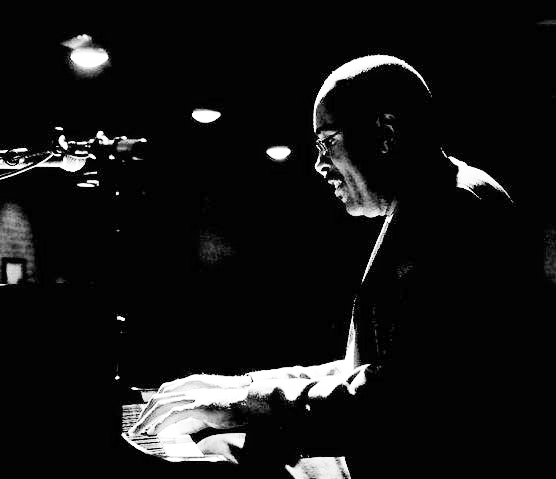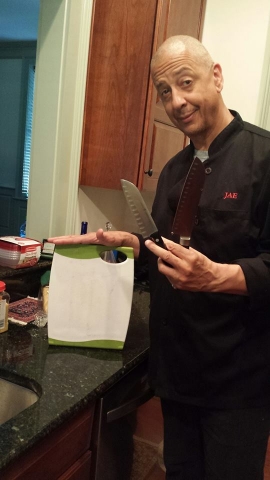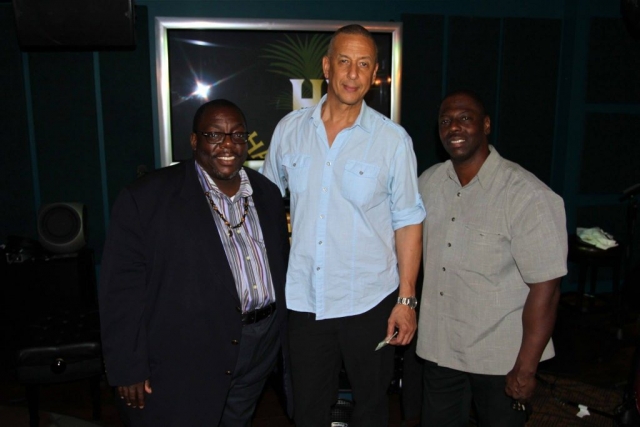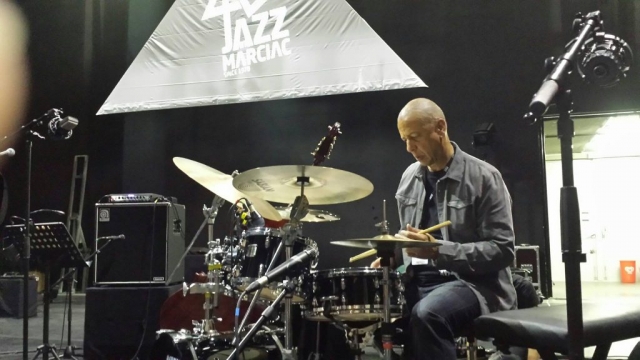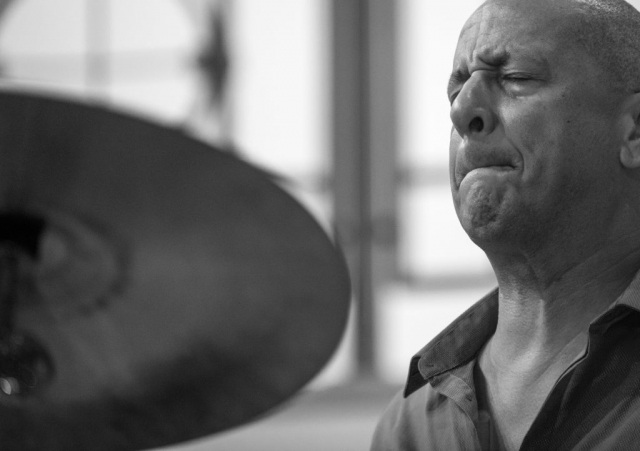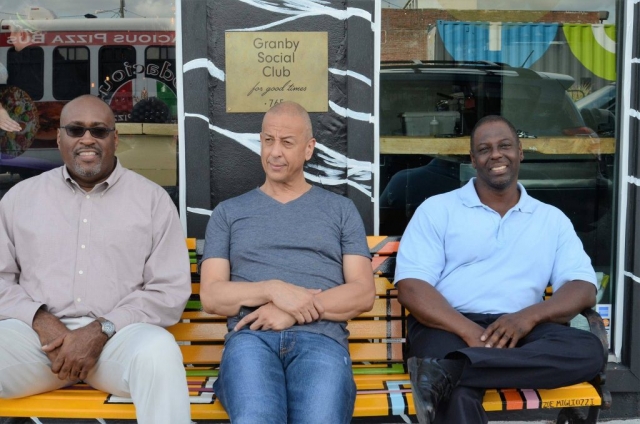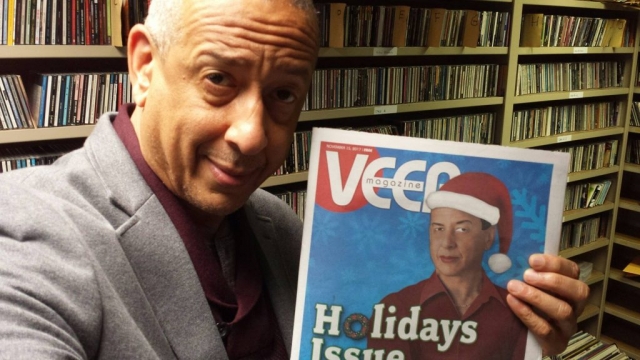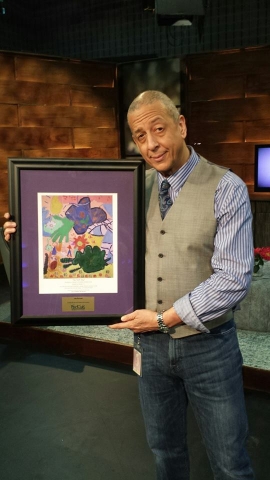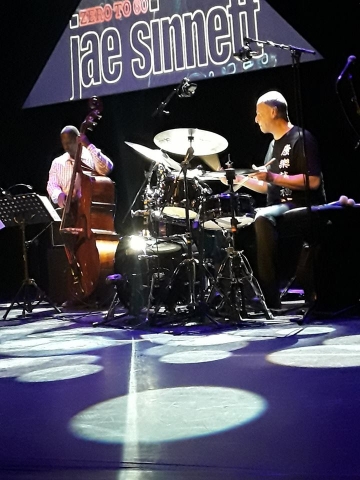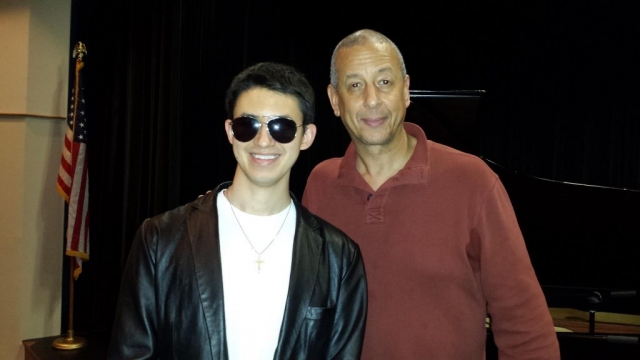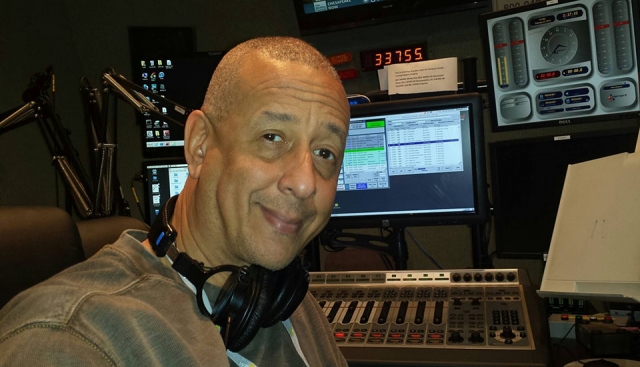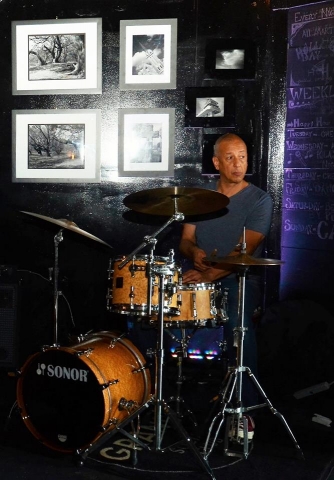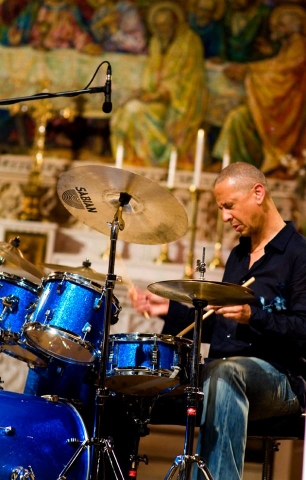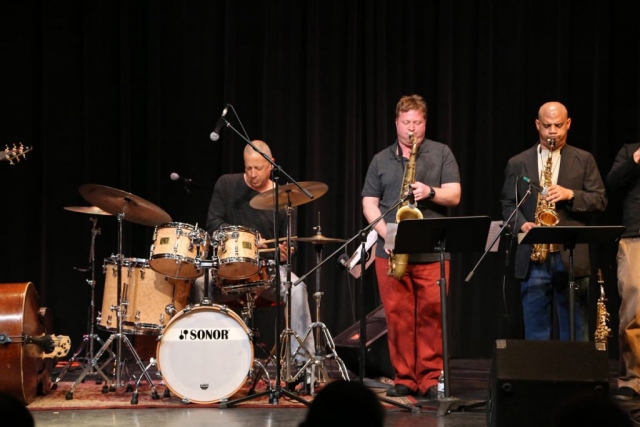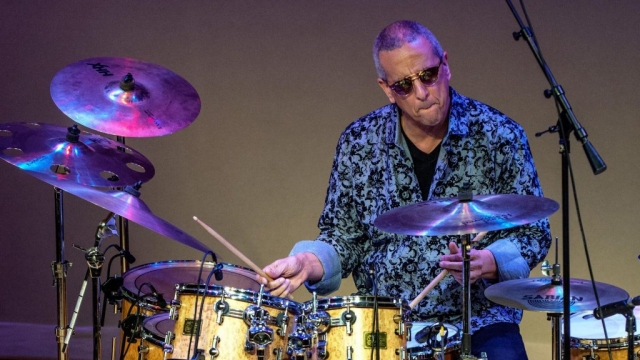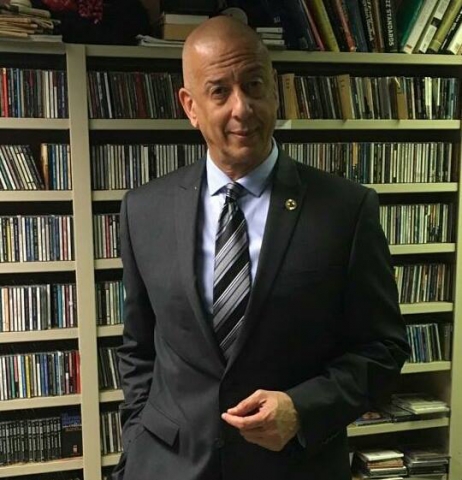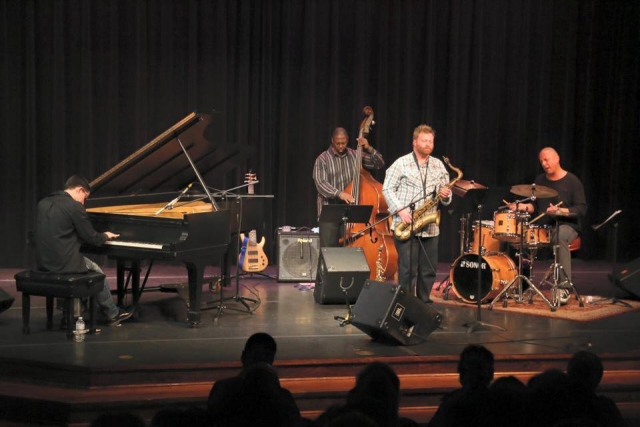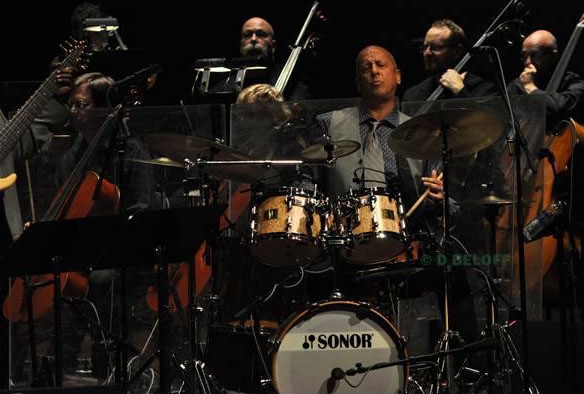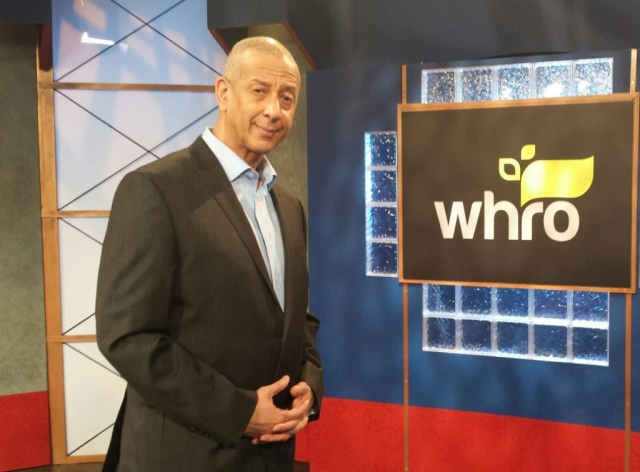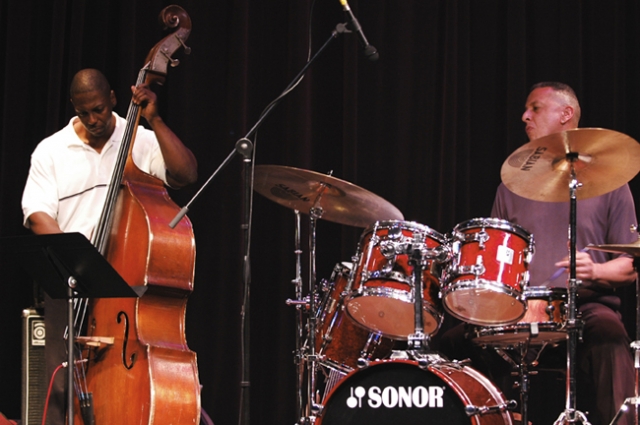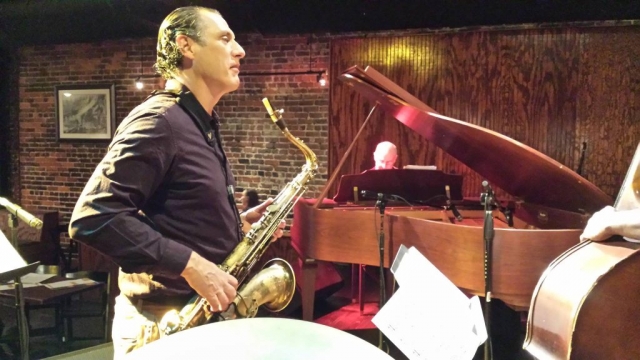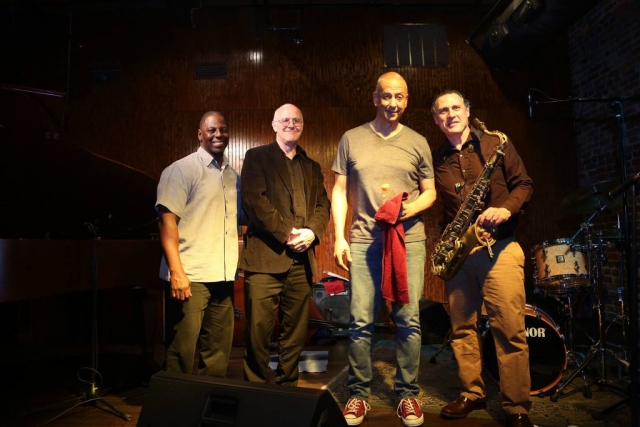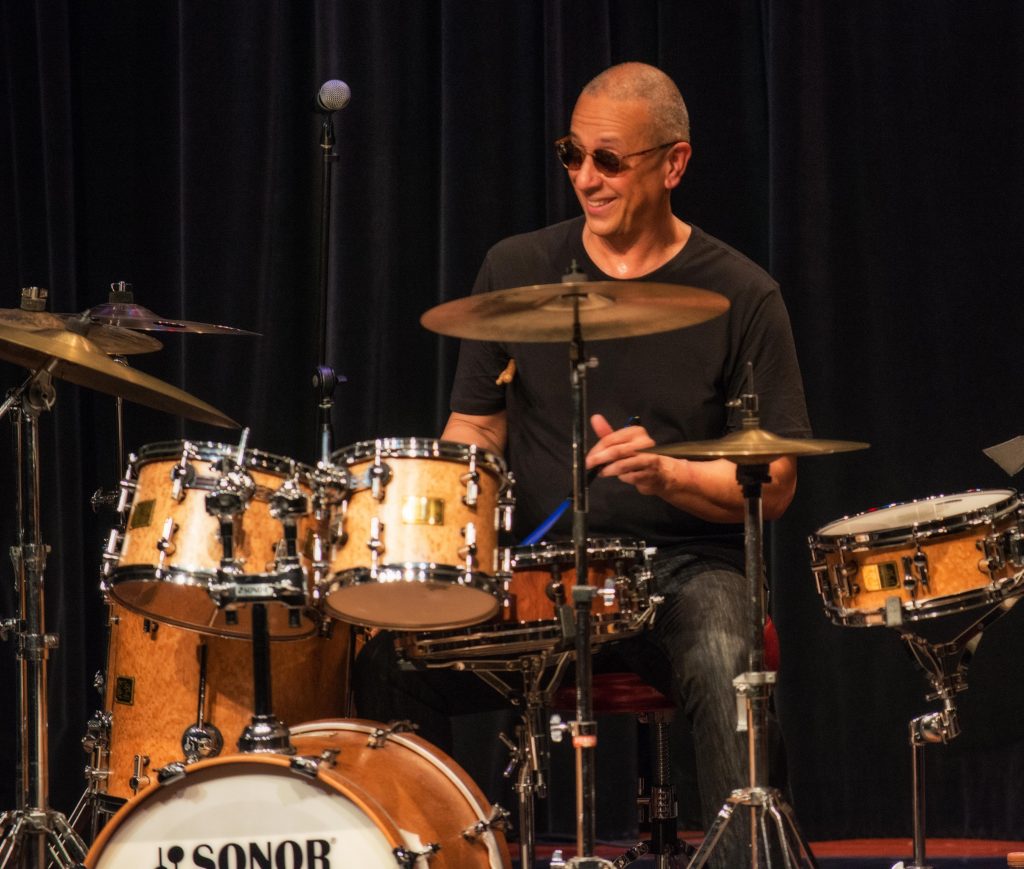Introduction to The Americana Groove Project
Print and Electronic Media: Jae Sinnett available for interviews – contact: jaejazz@yahoo.com
The Making of The Americana Groove Project
The Making of Zero to 60
Biography
A native of Donora, PA, Jae Sinnett came to Virginia in the mid-70’s to serve in the United States Navy. After completing his military service, he began his music career. He evolved into a consummate drummer, composer and bandleader who has produced 15 albums – the first of which, Obsession, was released in 1986. Featured were the former director of the Count Basie Orchestra, Frank Foster, on tenor saxophone, John Hicks on piano, Wallace Roney on trumpet, Steve Wilson on alto saxophone and Clarence Seay on bass. The swinging sextet album Blue Jae was released in 1992. House and Sinnett was released two years later and featured Cyrus Chestnut and Steve Wilson. Listen was released in 1997 with Jesse Davis on alto saxophone, John D’Earth on trumpet, Billy Pierce on tenor saxophone, and Allen Farnham and Cyrus Chestnut on piano. It went to the number one spot on the Gavin Jazz Radio Charts that July.
His fifth album The Better Half was released in April 1999 featuring the sensational saxophonist Chris Potter and Jae’s original trio with pianist Allen Farnham and bassist Terry Burrell. The Better Half reached number 10 on the charts that June. This recording represented a different musical direction for Jae’s writing. Following The Better Half, Off The Myopic Avenue was released in 2000 – also featuring the trio and saxophonist Elias Haslanger as the special guest. Confluence, Jae’s seventh album, was released in 2003 and is the first to feature the trio alone.
Jae’s “masterpiece” album The Sinnett Hearings was released in 2005 and features some of his best writing, arranging, and drumming. This is the first of his eight releases in which he wrote and arranged every composition. The Sinnett Hearings became his first jazz album to debut at number one on the national jazz radio charts in January 2006. It’s a beautiful and powerful vehicle that highlights the high-level musicianship of the group, as well as a soulful mix of thought-provoking grooves and improvisation.
The explosive It’s Telling…A Drummer’s Perspective was released in 2008 and became Jae’s most played album on Pandora. Every song is designed to feature Jae’s extraordinary drumming. It features his trio and saxophonist Steve Wilson.
“This is the recording I’ve always wanted to do to showcase what I feel is my true drumming ability. Every song is designed to feature the drums in various capacities. Truly, a compelling piece of work.” – Jae Sinnett
Complex, dense, introspective, and visionary, It’s Telling…A Drummer’s Perspective has it all and demonstrates the extraordinary musicianship of each member in the group.
In 2010 Jae formed a soul and funk ensemble called House & Sinnett and released the seriously funky album Old School Loyalty, featuring outstanding vocals, horn arrangements and writing. Jae’s first live album Theatre was also released that year featuring his other trio of Thelonious Monk piano competition finalist Justin Kauflin and bassist Terry Burrell. Still Standing was produced in 2012 and features the trio with both Allen Farnham and Justin playing on different tracks.
Subject to Change, Jae’s 13th album, was released in August 2014. It received positive reviews and debuted at the highest spot on the JazzWeek Radio Chart. The musicians participating in this recording were Jae on drums and keyboards, Steve Wilson on alto and soprano saxophones, Justin Kauflin on piano and keyboards, Terry Burrell on electric and acoustic bass, JC Kuhl on tenor saxophone, Rob DeDominick and Bill Brown on trumpet, and Duane Smith on electronic trumpet (#4).
In 2016 Jae released his critically acclaimed album Zero to 60. This marked his return to straight up jazz featured in the classic jazz quartet setting. Featuring Ralph Bowen on tenor saxophone, Allen Farnham on piano, Hans Glawischnig on bass and Jae on drums, Zero to 60 reached number one on the national JazzWeek Radio Chart for the week of April 4, 2016 and stayed in the top 50 for 20 weeks.
Following Zero to 60‘s success, Jae released his 15th album The Americana Groove Project in September 2018. The album is a mix of funk, blues, rock, soul, and jazz fusion. Jae also makes his lead singing debut on five tracks – Gotta Roll, Diddley Strut, Slights and Slings, Burnin Berman, and Higher Calling. The musicians participating in The Americana Groove Project are Jae on drums, keyboards, and lead vocals (tracks 2, 3, 5, 7, 9 – Rap (1)), Terry Burrell on bass, Jay Rakes on guitar, and Weldon Hill on Hammond organ. Special guests include Justin Kauflin on piano and and keyboard for tracks 1, 2, 4, 8 and 9, as well as Jennifer Gammill on background vocals for Burnin Berman.
Jae’s first performance/instructional video Musical Drumming Concepts was released in 2001. Modern Drummer magazine rated it an 8 out of 10. It highlights his compositions, philosophical teaching skills and drumming in various styles, meters and straight and swinging eighth note concepts. The trio released their first live concert DVD, An Evening with the Jae Sinnett Trio: Live at WHRO in 2009. The DVD was recorded in the television studios of WHRO, a public broadcasting station for the Hampton Roads, VA region.
Jae has written over 250 compositions. He has also scored music for five documentaries – one of which – John Biggers: Stories of Illumination – was aired on PBS. Jae’s dream of having his trio perform with the Virginia Symphony Orchestra was realized on October 10th, 2014 at the Ferguson Center for the Arts in Newport News, VA. The performance was met with outstanding reviews.
Jae’s other professional life has him in his 29th year as a jazz producer and host for NPR affiliate WHRV-FM 89.5 in Norfolk, VA. Jae hosts the popular jazz show Sinnett in Session Monday through Thursday evenings from 9 pm to 1 am and Sunday afternoons from 1 to 5 pm EST. He also hosts The R&B Chronicles, heard Friday evenings from 7 to 8 pm. Both shows can be heard on demand at mediaplayer.whro.org/person/jaesinnett. His Sinnett in Session jazz radio show is one of the highest fundraising and revenue-producing four-hour jazz shows in history.
At the 2018 JazzWeek Summit in San Jose, CA, Jae was awarded the prestigious Scott Willis Jazz Impact Award. In 1998, he was nominated for the Gavin Jazz Programmer of the Year award by his peers in the industry and has since been nominated five times. As a jazz educator, Jae taught history, theory and percussion at The Governor’s School for the Arts in Norfolk, VA for eight years. He also directed the GSA Big Band and Jazz Combos. He was an adjunct drum set and jazz ensemble instructor at Christopher Newport University in Newport News, VA. Jae attended Norfolk State and Old Dominion Universities as a music education major. He is a Sonor Drums and Sabian Cymbals artist and has been sponsored by both companies for over 20 years. He’s also a touring clinician and music educator, conducting master classes at many universities and appears as a guest artist with the ensembles performing his compositions.
Jae has performed with many artists over the years, including Branford and Ellis Marsalis, Joe Henderson, Freddie Hubbard, Chuck Mangione, Charlie Byrd, Herb Ellis, Chico Freeman, Arthur Blythe, Carol Sloane, Jon Hendricks, Randy Brecker, James Moody, Kenny Drew, Jr., Fred Hersch, Mulgrew Miller, James Williams, Jack Walrath, Makoto Ozone, JoAnne Brackeen, Andrew White, and Frank Morgan.
For more information about Jae’s music carer, email him at jaejazz@yahoo.com. To learn more about his radio broadcasting career, email him at Jae.Sinnett@whrv.org.
Daily Press Review – The Americana Groove Project
Jazz Man Jae Sinnett sings, and ‘grooves,’ on new CD
By Mike Holtzclaw, Daily Press
September 8, 2018, 4:00 PM
On his new CD, Jae Sinnett sings. He exhorts and whoops. He even raps.
This is new territory for Sinnett, who over 14 previous albums has made a name for himself as a jazz composer, bandleader and drummer. On The Americana Groove Project, he finds himself a singer at age 62.
So how does he feel when he hears himself on those new tracks? He lets out a nervous chuckle.
“It’s like I’m in a parallel universe, man,” he said. “I can’t believe it’s me singing. I haven’t sung in any serious capacity in 35 years. I never sang lead in any capacity. I was in the church choir growing up. I sang background harmonies in disco bands in the 70’s. But honestly, I don’t sing at all outside of my shower.”
He wasn’t planning to sing on Americana Groove either. This collection of songs was already going to be a departure, especially after his 2016 release Zero to 60, which took him back to the pure sounds of a traditional jazz quartet with drums, bass, keyboard and sax. His inspiration for The Americana Groove Project was the emotional highs he drew from listening to soulful vocalists such as Ray Charles, Sam Cooke and Aretha Franklin.
He knew he wanted to experiment with catchy funk grooves played over unexpected tempos. He wanted lyrics and vocals, but the local singers he lined up kept backing out.
“I’m singing by default,” he said. “It came down to me getting tired of asking people to do it. In a pensive mood one night, I looked in the mirror and said, ‘OK, I’ll try it.'”
His first call was to Sondra Gelb, whom he has known for decades since they were both instructors at the Governor’s School for the Arts. Gelb, who lives in Virginia Beach, is a contralto who sang for several years with the New York Opera.
She quickly determined that his voice had a nice, warm pitch and that his years of drumming and composing had provided him with an innate sense of how to approach a song. Other than helping him with some vocal warm-up techniques, Gelb said her biggest role was building up his confidence to deliver the vocals he already had in him.
“I told him, ‘You don’t need to hire somebody to sing this,'” Gelb said. “Thank goodness three singers bailed on him, because I’m blown away by what he did. I knew he could do it, but I didn’t know how calm he was going to be. Jae’s kind of chill about everything, but it just looked like he’d been doing it his whole life.
“He has a natural sound. You can’t teach somebody instincts. All you can do is help them with what they’ve got. He took it and flew.”
Indeed, the first instrument heard on the opening track, Bump in the Road, is Sinnett’s voice, intoning to his band: “Yo, let’s play this joint.” What follows is a funk groove played over a 9/8 drum tempo, and Sinnett rapping about facing up to life’s challenges. It may be the most unexpected track of his 24-year recording career.
The other eight tracks on the CD are equally eclectic. Diddley Strut is a Bo Diddley lick played hard by Jay Rakes, a Kecoughtan High School graduate whose guitar work takes center stage on many of the songs.
The album ends as improbably as it began – with Sinnett channeling Al Green and the Rev. James Cleveland on Higher Calling, a sweet gospel song tapping into Sinnett’s spiritual desire to become a better person than he was the day before.
“That song, Higher Calling, was a true vocalist’s song, in my opinion,” Sinnett said. “That really, really requires singing – just getting down to the essence of the true song. That presented the biggest fear to me.”
The songs from The Americana Groove Project already are being played on WHRV-FM 89.5, and the disc will be released nationally this week.
Sinnett understands that people will be surprised to hear him singing, but he hopes that does not take the focus away from the music he composed and the band that played it. In addition to Rakes on guitar, Sinnett is playing here with longtime bassist Terry Burrell and with Weldon Hill on the Hammond organ. Pianist Justin Kauflin, a former Sinnett protege who just released his second album with legendary producer Quincy Jones, sits in on a couple of tracks.
His goal in assembling this band, very different from the Zero to 60 quartet, was less about technical virtuosity and more about emotional intensity. Less about how the music sounds and more about how it feels. That goes for his own playing as well – behind the drum kit, Sinnett found himself tapping into Clyde Stubblefield’s work with James Brown, and Mitch Mitchell’s jazz-inspired rhythms on Jimi Hendrix’s Are You Experienced?, Ginger Baker with Cream, and Al Jackson on the great Stax records. Funky blues out of New Orleans.
“That’s the foundation of when I learned to listen to music – how to listen,” Sinnett said. “Rhythms that get in your head and don’t leave. What I decided to do was use some of those ideas as the rhythmic foundation, but restructure them to my thinking. I wanted to build songs on top of those rhythms, and put a modern touch on some of them, like with the rap, for example.
“None of that was played in 9/8 time, but the grooves all have some historical connection to what I experienced as a child.”
Two years ago, Zero to 60 hit No. 1 on Jazzweek’s national airplay charts. Sinnett is not sure what to expect of The Americana Groove Project, but he is satisfied that he and the band brought his vision to life.
Now, he faces another quandary: When it comes time to play these songs live, will Sinnett sing or play the drums? Whichever role he chooses, he will have to hire someone for the other.
“Let’s see what people react to, the vocals or the instruments,” he said. “So far, 99 percent of the people listening reacted to the vocals. That’s terrifying to me, but also a good thing. It puts me in a position of seriously having to come out front and sing.”
It’s something he never could have imagined a year ago.
He couldn’t imagine it now if he didn’t believe in the songs.
“A lot of what I’m missing in music today is what I’m talking about here,” he said. “The soul is gone in a lot of music that’s coming out these days. There’s a reason the boomers keep coming back to that music. There was so much humanness in the music back then. It was about the interactiveness of the musician.
“That’s another part of what I wanted to revisit – that group concept. And this goes back to that first question: I hadn’t even thought about singing when I was composing these songs. It’s all about the drums with me, man. I knew I wanted vocals, but I wanted vocals integrated into the band. I’m in a weird position now. It’s out of the box. Now what are you going to do?”
Veer Magazine Review – The Americana Groove Project
With “Americana,” Sinnett Plays Outside The Box
September 10, 2018
Categories: Featured, Music, Music News
By Jeff Maisey
Perhaps jazzman Jae Sinnett took a cue from radio colleague Paul Shugrue’s Out of the Box program when he decided to explore a multi-genre approach to his new CD The Americana Groove Project.
As a jazz recording artist, percussionist/composer, Jae Sinnett has 11 albums to his credit including his 1992 debut Blue Jae, 2000’s Off the Myopic Avenue, and the critically acclaimed Zero to 60 (2016) and Still Standing (2012).
The Americana Groove Project is an interesting title choice for Sinnett. Americana is a known musical genre steeped in bluegrass mountain music. Even the “Americana” font on the CD cover hints at down-home country.
Imagery aside, Sinnett’s The Americana Groove Project is a fantastic artistic expression melding blues-rock, funk and soul with jazz fusion a la Return to Forever’s Romantic Warrior album. Overall, this album fits right in with New Orleans blues/rock bands with its blistering guitar work supplied by Jay Rakes, big-time bass grooves laid low and heavy by Terry Burrell, and some fine organ work courtesy of Weldon Hill.
The biggest surprise on the album is this: Jae can sing.
Say what?
Yep, seems Sinnett’s guest vocalists fell through when it came time to record, so the drummer/songwriter took Nike’s “Just Do It” advertising slogan to heart.
Sometimes accidental discoveries are the best, and Sinnett’s newfound talent adds an unexpected dimension to songs like the rhythmic scat-meets-soul Gotta Roll, a surefire hit. On the opening Bump in the Road Sinnett talk-sings sparsely on a tune that could be happily set in the 1970s, but with a contemporary quip, “it’s just a bump in the road, yo.” Singing all the parts on Slights and Slings, Sinnett delivers a tune that will have audiences joining in word for word on the chorus. Burnin Berman cooks at a high tempo and off-beat time signature, and yet Sinnett’s vocals are right on the money – perhaps his most impressive delivery, though his Sade-like approach to Higher Calling is pretty smooth.
Sinnett and company also shine bright on the album’s instrumental tracks. Where guest keyboardist Justin Kauflin provides some nice fingerwork as a compliment to Rakes’ melodic guitar lines on Thinkin Bout Where Ya Been, the group injects a blurring of prog rock, blues and gospel to After the Storm for a nice change of pace.
In case you’re wondering, Sinnett’s new recording project isn’t his first foray outside the jazz realm. In 2014, Sinnett released the 8-song Subject to Change, a mostly R&B-flavored album featuring the vocals of Myra Smith.
Jae Sinnett’s The Americana Groove Project will surprise and delight.
People get ready, Jae came to play.
No Depression Review – The Americana Groove Project
Jae Sinnett blurs the divide between various genres and styles
Jae Sinnett – The Americana Groove Project
By Stacey Zering
September 18, 2018
Jae Sinnett is a really talented and eclectic artist who has just unleashed a new powerful album, The Americana Groove Project. One of the most mesmerizing things about this record is definitely the way that it seamlessly blurs the divide between various genres and styles, including urban, funk and jazz fusion, only to name a few.
Jae is able to go through exciting grooves and fantastic arrangements with cat-like reflexes, going for a very fast-paced, direct and dynamic flow. This artist certainly knows how to keep the engagement levels really high, enticing the audience with every beat. If you enjoy artists such as Stevie Wonder, D’Angelo or Prince, you are definitely going to love this release. In addition to the sharp songwriting and performance value offered by Jae, one of the things about The Americana Groove Project which truly stands out is the high production values, and the mix is balanced and punchy. The tone and feel of this release is quite exceptional and refreshingly uplifting, creating a really good balance between the warmth of the old guard and the crisp approach of the modern age.
Website:
Featured Interview – No Depression
Interview: Jae Sinnett
By Stacey Zering
November 15, 2018
Source: http://nodepression.com/interview/interview-jae-sinnett
Q: What was your introduction to music? How old were you, and how did it affect you?
A: The music genres I heard most in our home as a young boy were gospel and soul with the blues sensibilities. This was a few years before I started playing an instrument. Little did I know at the time, that listening to those styles would set the framework for how I would FEEL music once I started playing the drums. That soulful foundation was established. The soul, passion, energy and the emotional layers of the blues. I started playing drums around seven or eight years old. When I saw the Beatles on the Ed Sullivan Show in February of 64…seeing Ringo playing in that context… did it for me. I knew I wanted to play drums from that moment on. Not stylistically like him but playing drums and creating music.
Q: Did you grow up in a musical environment?
A: My grandmother sang in the church choir and my mother played the piano in church. I eventually started singing in the choir too. My first musical interaction with other people. I kick myself to this day for not asking my mother to teach me piano back then but for me it was all about the drums. Then in high school I started playing drums with the school band. That’s were I got by first bit of music education and also started playing in a band with some of my school friends. Mostly rock. I never had lessons up to that point but I was great at interpreting what I heard. Seeing things too because it helped me in developing my technique…watching other great, trained players and getting pointers from them.
Q: What styles of music had the greatest impact on you?
A: Firstly, gospel. Then soul. Then rock. The classic concepts of those genres by today’s standards. Jazz came years later. Listening to music was very different back in the 60’s. My friends and I would have listening sessions. We would buy a couple of 45’s and bring them into the sessions and just sit and listen over and over… then talk about what we heard. Musicians and non-musicians were part of these listening circles. It was cathartic. Very different today and as I mentioned earlier those styles played a profound and significant role in how I would eventually play music. The music that means the most to those listening is the music you feel. That’s what connects you. That deep soul is what’s missing, in my view, in much of today’s popular music.
Q: How would you describe musical style?
A: That’s a tough one but here goes. The Americana Groove Projectfor example is multi genre and reflects my many musical influences. I’m having a hell of a time trying to narrow it down to one style. I think years ago the lines were definitely blurred in separating genres. At times, instrumentally, the music was the same between say…blues and rock but the vocal content was different and usually the forms but conceptually they were the same. Often times what was sung helped to define if you were playing blues or rock. Over time rock became more melodic…getting away from traditional blues harmonic structures. I know the blues and funk when I FEEL it…which is different than hearing it. Rock too but rock eventually got away from the elasticity in the rhythm like soul. Listen to and feel Cream as one example and listen to rock today. Totally different in the way the rhythm flows. Rock, like the blues, is guitar heavy but rock tends to use more distortion or effects. Soul…bass and drums. These are simply examples of differences in trying to help define a style but the common thread in the genres…particularly back in the 60’s…was the blues which is an emotional experience. Much of rock today is void of the blues and the elasticity of the rhythm of soul has changed. Straighter eighth notes in phrasing. R&B at its inception was more instrumental and had blues and some jazz at its foundation but repetitive rhythmically. Soul merged blues, R&B and gospel and was more vocal. Pop takes the lowest common musical denominators of the aforementioned genres and is produced for the sole purpose of making a hit record. Your question is complex and trying to answer without getting into musical descriptions is tricky.
Q: When did you learn to write songs and what was that process like?
A: One of my best friends, saxophonist Abdu Salim, was my first “jazz” harmony and theory teacher. When I was in college I was exposed to a different kind of theory but jazz theory was what intrigued me. This was coming into the early 80’s and at this point I was playing jazz. He was in the ARMY and taught at the Armed Forces School of Music. He and I started playing together and he would always say to me…”just because you play drums doesn’t mean you should get a pass on having to learn harmony and theory.” He would bring me books from the school and I would study deeply. He’s also an amazing writer. I learned a tremendous amount about composition from him. Being a drummer too help to spur on my desire for composition. Drummers in popular music are basically time keepers. Not much creative freedom. I got tired of the repetition and limited creative possibilities and started to develop my own ideas but I realized that if I was going to be able to play drums the way I heard it in my head, I had to learn to write my own music. The first time I played my music with a band was unbelievable. One of my dreams was to play my music with a symphony orchestra and we did a couple of years ago with the Virginia Symphony. That was truly amazing!!! I’m playing my ideas and developing my style and sound. It’s incredibly therapeutic writing and was/is immensely rewarding and spiritually and emotionally fulfilling when I get the opportunity to play my music with other musicians.
Q: Which of your songs on The Americana Groove Project are most personal to you and why?
A: Each song is structured over a specific and thought out groove or beat so they’re all unique and special to me in different ways. Conceptually, Higher Calling is one because it reflects much in how I view my faith. Slights and Slings is another because of the groove. I love that groove and it reflects this rhythmic elasticity I was speaking of earlier and is reminiscent of some of the first grooves I every learned. I love how the song develops too. I’m a firm believer in that a song has to move forward in it’s energy and purpose. Midnight Jam was a blast and it came together after a long night of recording. It wasn’t in the plans. My bass player Terry Burrell and I, would occasionally mess around with that groove over the years. Never did much with it…until that night. We were exhausted and after we were done recording, I just started playing that groove. Then Terry came in and then the rest of the band. Little did we know the engineer still had the tape rolling and I’m glad he did. We were just jamming and having fun not knowing we were being recorded. Talk about in the moment playing. It’s also important to note here, I wasn’t planning on singing. This is one of the most important things for me about this project. I asked three singers and they all said yes at first and then mysteriously, at different times, all said no. Without EVER hearing a note of the music. We never got together. It was the strangest thing and after some deep moments of contemplation, I said I will try it. I never sung lead before in any capacity. It was a crazy thought in my head but in the end I’m glad I did it. I sang backup in a band and in the church choir when I was young as I stated earlier but never lead. So when you ask which songs are the most meaningful to me…ALL the vocal tunes 🙂 I’m proud of how they turned out.
Q: What artists influenced you the most growing up?
A: Many…for different reasons. The Reverend James Cleveland for his passion. Ray Charles for his soul. Just about any of Motown’s artists for their commitment to excellence and organization. James Brown and Clyde Stubblefield for their funk. Stax Records artists such as the Bar Kays, Issac Hayes and Otis Redding. Whew! Unbelievable soul! The Meters out of the Crescent City. John Coltrane for his power, technically facility and the intense spirituality he injected into his music. Drumming greats Tony Williams, Elvin Jones, Art Blakey, Philly Jo Jones, Jack DeJohnette, Vinnie Colaiuta, Steve Gadd, Steve Smith, Buddy Rich and many, many more for their extraordinary artistic brilliance and inventiveness.
Q: How have you evolved creatively?
A: I evolved into appreciating and respecting space and patience. I realized after years of playing the one thing that means the most to me is how it makes me feel and how I can make what I play feel. It’s not the technical virtuosity. On some earlier recordings it was about “choppin” and I was left emotionally empty. It was fun and I was intellectually stimulated but little stuck with me. I go back to the records that make me feel good. Even my own and that’s the beauty of The Americana Groove Project. How it makes me feel. It has an old school sensibility but with modern touches.
Website:
Reviews of Zero to 60
“Whilst the complexities of the music on Zero to 60 present each musician unique harmonic, melodic and rhythmic challenges, the simple fact is that the listener can walk away feeling totally satisfied, not only fully content with what has been heard, but humming a tune with glee. That’s the beauty of Sinnett’s writing. The compositions are clever in a jazz writing sense, but they’re just so tuneful, catchy even. Add to that the incomparable performances from each member of the quartet and what we have is an awesome album of straight-ahead jazz at its very best and most rewarding.
“Every track on Zero to 60 stands out, there are no weak links here. Passionate, driving grooves, inventive soloing and fiercely enigmatic performances make for a wonderfully dynamic album. The writing never resorts to cliché, the whole album being full of a spirit that sets it apart from the vast majority of recordings one might hear in this field of music; refreshingly authentic and oozing class.
“Zero to 60 is one fine album. As the band leader himself puts it; ‘Zero to 60 is filled with the emotional sensibilities that bring home the point of why you listen to the music in the first place. How it makes you feel.’ I couldn’t have put it better myself.” – Mike Gates, UK Vibe
“The title of this record is something of a double entendre, referencing both the arrival of a milestone birthday for drummer-composer Jae Sinnett and the specific decade that helped influence his outlook on music, art, and life in general. But don’t let that information fool you. This isn’t some nostalgia-filled date with flower power filigree. This is modern jazz that sells itself through the marriage of sophistication and accessibility. And while those two might seem like strange bedfellows, they shouldn’t. There’s no reason that music can’t be catchy and intricate at the same time, and this record successfully makes that argument.
“With thirteen other albums to his credit over the past three decades, a quarter century of work as a jazz radio personality, a sterling reputation as an educator, and vast composition credits spanning genres and formats, Sinnett has practically done it all. He brings all of that experience to bear on this album, merging powerful thought and pleasing ideas with nary a problem.” – Dan Bilawsky, All About Jazz
“American Classical Music, commonly referred to as Jazz, has produced a long history of extraordinary talent. Jae Sinnett is no exception and joins the elite corps of contributors to the only art form that developed in America along with American Indian Art. I was first introduced to Jae’s music via The Sinnett Hearings, which remains one of his most interesting presentations I have been privileged to listen to. His latest, Zero to 60, is full of thought provoking performances and the pulse is never forgotten…be it up tempo or the beautiful Omega closing the set. Excusez-moi for the beautiful use of mallets Jae!!! I am curious at this point as to whether Jae names the compositions or like myself, the compositions dictate to me what they want to be titled. Quail Creek causes one to be there and here is a composer that has been given a gift that makes one think on many levels. Music is supposed to do just that. This is what this wonderful art form is about. The artist, writer, performer or orchestrator…be it Ravel, Ellington, Strayhorn, Art Tatum…and in this case Jae Sinnett, are classic examples of stirring the emotions of laughter, tears, reflection and all the areas of this life we live…leaving you with an experience that remains!!! Carry on, Mr. Sinnett with your many gifts!!!” – Ahmad Jamal
“Drummer and composer Jae Sinnett’s new release Zero to 60 is a delight. Filled with gentle surprises and a wide variety of grooves, Jae’s selection of songs leads the listener on a rewarding journey, from the utterly modern and swinging Double Dribble to the poignant Quail Creek; through an unexpected medium-tempo Never Let Me Go. Leading a band made up of deep and potent sidemen, who are also revered musical leaders in their own right, Jae has captured the spirit of jazz music without ever resorting to cliché. His songs are concise and singable – a rare quality in a modern jazz composer. I am thankful for this thoroughly enjoyable and masterful CD, and look forward to much more of Jae Sinnett’s musical journey in the future!” – Saxophonist Joel Frahm
“The CD is exceptionally well played, with Allen Farnham (piano), Hans Glawischnig (bass) and Ralph Bowen (tenor saxophone) rounding out this fine quartet; and exceptionally well-recorded (the sound is just brilliantly recorded and engineered). Memorable melodies and a distinctly positive energy – I’m anxious to get this one on the air on my weekly jazz program!” – Dr. Brad Stone – Host – The Creative Source
Featured Review – All About Jazz
By DAN BILAWSKY
Published: February 24, 2016
Views: 8,615
Jae Sinnett: Zero to 60
The title of this record is something of a double entendre, referencing both the arrival of a milestone birthday for drummer-composer Jae Sinnett and the specific decade that helped influence his outlook on music, art, and life in general. But don’t let that information fool you. This isn’t some nostalgia-filled date with flower power filigree. This is modern jazz that sells itself through the marriage of sophistication and accessibility. And while those two might seem like strange bedfellows, they shouldn’t. There’s no reason that music can’t be catchy and intricate at the same time, and this record successfully makes that argument.
Exhibit A in Sinnett’s case on the compatibility of the aforementioned qualities is the album opener – Double Dribble. It’s a tune that hurdles forward in three, halts and changes gears with layered entrances over a riff in seventeen, and shifts into streamlined 4/4 swing. All of that happens within the first minute of the pieces, and all of those different moving parts, along with a few other twists, come back at one time or another. So does all of that lend the music a dizzying quality and make it incomprehensible? Absolutely not. By the second listen the riffs are already permanently lodged in the mind. Every tune that follows, while not necessarily as metrically complex, walks that same line, adopting no-nonsense musical tactics while also proving to be completely approachable from the listener’s side of the fence. There’s Farm Hands, opening with a hypnotic two-against-three feel before shifting gears into swing; Hans Up! which artfully moves from a funk-laced groove to a Brazilian-influenced feel while referencing bassist Hans Glawischnig’s contributions in name; Bowen’s Arrow, an intense feature for saxophonist Ralph Bowen with precision hits and a metronome-bustling swing drive; and the title track, driven by Sinnett’s perky drumming and the chordal jabs of his longtime pianist, Allen Farnham.
Elsewhere on the album, Sinnett furthers and broadens the picture by looking back. Quail Creek, for example, takes a spiritual, Coltrane-influenced path, and the lone standard on the record – Never Let Me Go – plays to tradition with its straightforward approach and trading of solos. Sinnett manages to address jazz from numerous angles here, which should come as no surprise to anybody familiar with the man. With thirteen other albums to his credit over the past three decades, a quarter century of work as a jazz radio personality, a sterling reputation as an educator, and vast composition credits spanning genres and formats, Sinnett has practically done it all. He brings all of that experience to bear on this album, merging powerful thought and pleasing ideas with nary a problem.
Track Listing: Double Dribble; Farm Hands; Quail Creek; Hans Up!; Watch Your Step; Never Let Me Go; Bowen’s Arrow; Whispering Souls; Zero to 60; Omega
Personnel: Jae Sinnett: drums; Ralph Bowen: tenor saxophone; Allen Farnham: piano; Hans Glawischnig: bass
Year Released: 2016 | Record Label: J-Nett | Style: Straight-ahead/Mainstream
Jae Sinnett’s Americana Groove Project Live at The Vanguard – Just Another Rain Song
Jae Sinnett’s Americana Groove Project Live at The Vanguard – Red House
Gotta Roll
Diddley Strut
Higher Calling
Jae Sinnett’s Zero to 60 Quartet – Quail Creek – Live at the Attucks Theater
Jae Sinnett’s Zero to 60 Quartet – Video Montage – Live at the Attucks Theater
Jae Sinnett’s Zero to 60 Quartet with Denise Donatelli
Jae Sinnett’s Zero to 60 Quartet – Double Dribble – Live at the Attucks Theater
Jae Sinnett – Drum Session – Soloing Over an Ostinato – Thematic Development
Drum Lesson – The Art of the Musical Solo with Jae Sinnett
Drum Lesson – Hand Technique Studies with Jae Sinnett
Contact
Jae specializes in drumming, composing, facilitating drum clinics and master classes, as well as hosting Sinnett in Session and The R&B Chronicles on WHRV-FM 89.5 in Norfolk, VA. For more information, please email him at jaejazz@yahoo.com.
